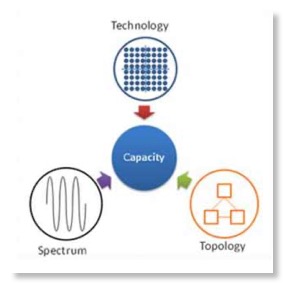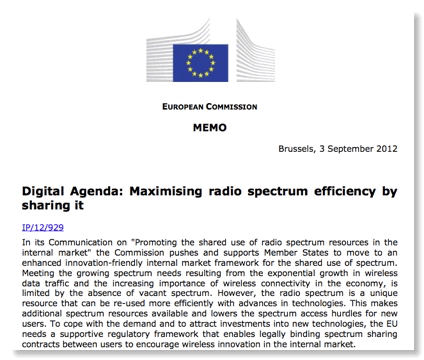CTIA Can Be as Rigid as NRA is on Gun Control

And where will this new spectrum come from? Wireless Week writes
“Largent stressed the need for the FCC, as well as the President, to pressure government agencies like the Department of Defense, to clear unused spectrum for commercial use. ‘It's really hard to pry this spectrum out of their hands...It's incumbent on the president and the FCC to pressure them to give up some of this spectrum’ ”
Largent’s staff then tried to outdo their boss on rigidity.
“Chris Guttman-McCabe, CTIA's vice president of regulatory affairs, made it clear that spectrum sharing is not the end goal, noting that the report from the President's Council of Advisors on Science and Technology (PCAST), which recommended sharing airwaves a matter of policy did not have adequate input from the wireless industry. "There were no infrastructure vendors, no handset vendors at the time and no carriers," Guttman-McCabe said of PCAST. "We believe here, there needs to be a focus on clearing...as a fallback, we are perfectly comfortable investigating sharing...but with the goal of eventually clearing that spectrum."
So PCAST did not have any industry insiders as members. Can you imagine that the White House does not view the techies of the cellular infrastructure vendors, handset vendors and carriers as not meeting their criteria as “the nation’s leading scientists and engineers”.
As a public service, here is an extract from the PCAST report listing the PCAST members and “Invited Experts” involved in drafting it. Isn’t Largent’s predecessor Tom Wheeler there? Now sources tell me that Wheeler really wasn’t very active in drafting the report, but he certainly was in the inner circle. Isn’t Dale Hatfield, my former boss and a close friend of CTIA there also? Note that CTIA proudly posts on it website the following video of Dale saying at a CTIA conference “ we can no longer afford to sacrifice spectrum due to inefficient technology.”

At least Chris is willing to consider sharing as a “fallback”. What if it really works? Will CTIA at least consider that possibility? Is the need for readily available Chinese made equipment in all cellular bands really a key driver in spectrum policy. It is ironic that he says this as Sprint has foresworn Chinese suppliers for the core of their network.
Lest CTIA think that the evil sharing is a concept only advocated by irrational cellular industry enemies at FCC and NAB, perhaps they should review the following document from European regulators:

This EC memo has statements like
The radio spectrum is a finite resource – there is no vacant spectrum remaining, and the cost of re-allocating spectrum to new uses is high. On the other hand there is an exponential increase in the use of spectrum – for example driven by mobile computing devices, Wi-Fi hotspots but also smart electricity grids and industrial automation. This creates challenges for meeting the growing demand for spectrum.
However, thanks to advances in technology, it is now possible to share the spectrum more efficiently. Many new wireless technologies are designed to share bands in which no licence is required (licence-exempt bands), while others make additional spectrum resources available by, for example, providing wireless broadband services in between TV frequencies (the 'white spaces'). To maximise the benefits of spectrum sharing, regulatory barriers need to be removed and incentives provided. This requires new regulatory approaches to give different users the right to use a given frequency band on a shared basis...
The main reasons are the economic incentives to use spectrum efficiently by getting more out of the same amount of spectrum wherever technology allows it. The proposed approach is firmly based on the need to provide economic incentives for innovators and incumbents alike..
For example public entities that are incumbent right holders could offer access to spectrum capacity to commercial operators in return for co-funding of network infrastructures, for example for broadband public protection and disaster relief (PPDR) applications. Commercial operators will be able to recoup investment costs by sharing spectrum in areas or at times of the day that their spectrum is underutilised. On the other hand, innovators who can compare sharing opportunities in a competitive internal market could use economic incentives to encourage incumbents to share spectrum, if they have an innovative technology that allows it. In order to reach the economies of scale that stimulate such innovations, the EU needs a common approach in the internal market to identify beneficial sharing opportunities across the entire radio spectrum.
So sharing is not the result of anticellular industry “dark forces” lurking in Washington, it is a concept that is moving faster than the cellular industry wants it to move in order to balance using today’s technology available resources with growing capacity needs while addressing other uses of spectrum that are also valuable to societies and economies.




![Validate my RSS feed [Valid RSS]](valid-rss-rogers.png)

